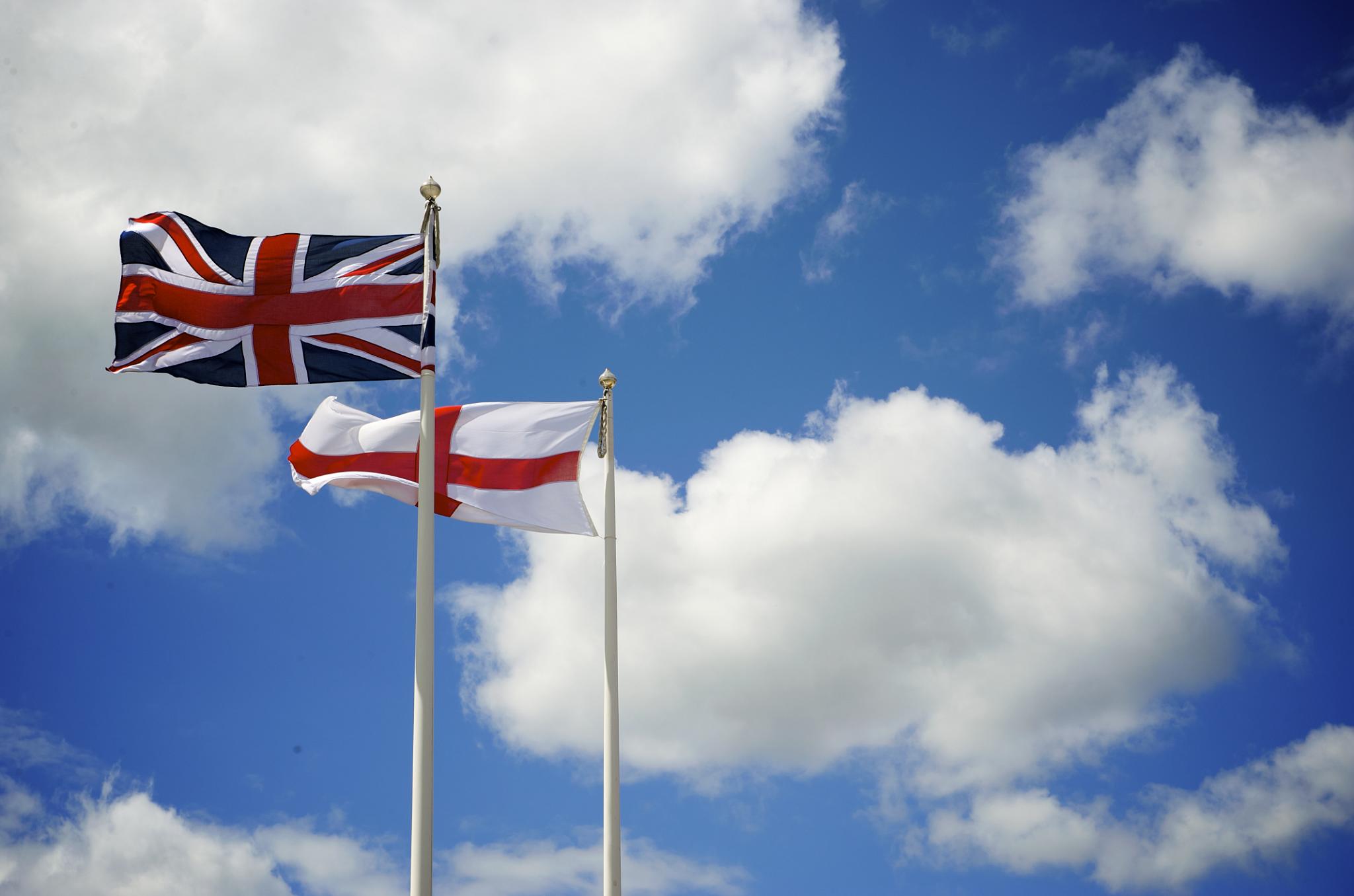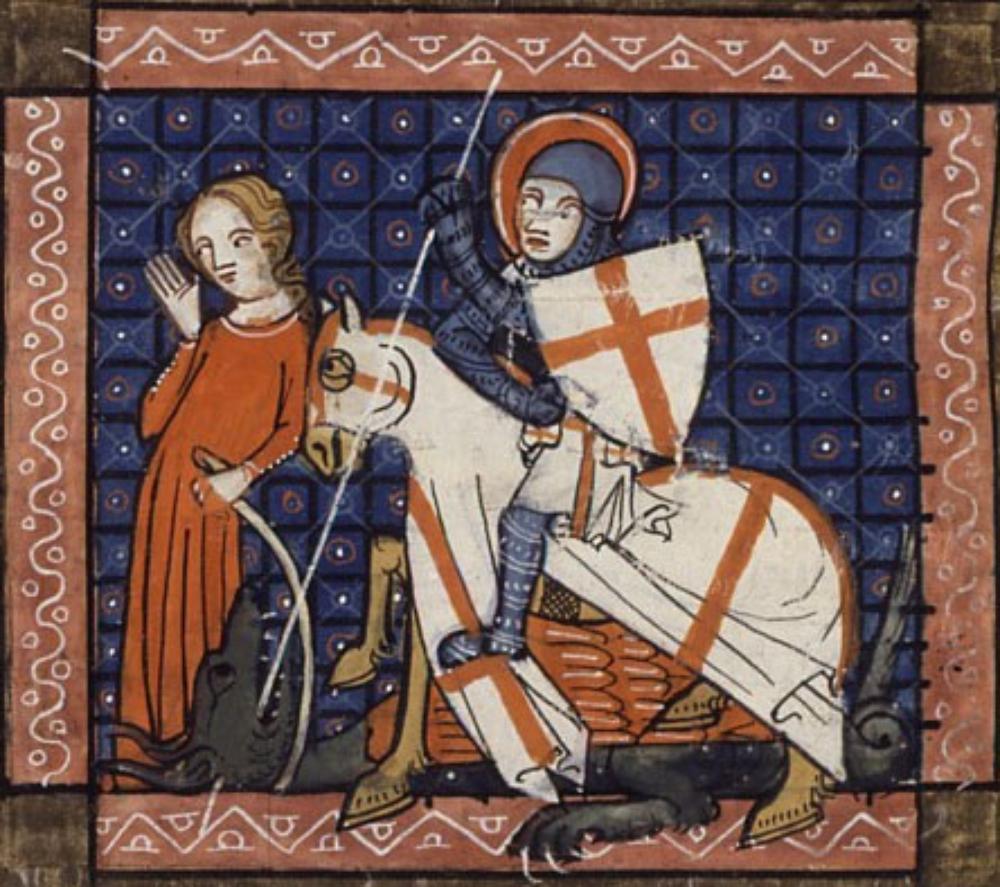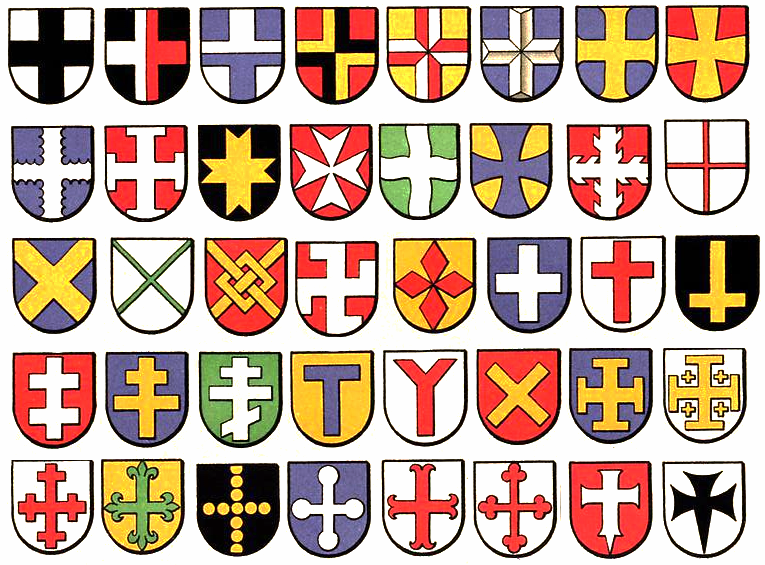|
Flags Of The Holy Roman Empire
The flag of the Holy Roman Empire was not a national flag, but rather an imperial banner used by the Holy Roman Emperor; black and gold were used as the colours of the imperial banner, a black eagle on a golden background. After the late 13th or early 14th century, the claws and beak of the eagle were coloured red. From the early 15th century, a double-headed eagle was used. In 1804, Napoleon Bonaparte declared the First French Empire. In response to this, Emperor Francis II of the Habsburg dynasty declared his personal domain to be the Austrian Empire and became Francis I of Austria. Taking the colours of the banner of the Holy Roman Emperor, the flag of the Austrian Empire was black and gold. Francis II was the last Holy Roman Emperor, with Napoleon forcing the empire's dissolution in 1806. After this point, these colours continued to be used as the flag of Austria until 1918. The colours red and white were also significant during this period. When the Holy Roman Empire too ... [...More Info...] [...Related Items...] OR: [Wikipedia] [Google] [Baidu] |
Albrecht Altdorfer 044
Albrecht ("noble", "bright") is a given name or surname of German origin and may refer to: First name * Albrecht Agthe, (1790–1873), German music teacher * Albrecht Altdorfer, (c. 1480–1538) German Renaissance painter * Albrecht Becker, (1906–2002), German production designer, photographer, and actor * Albrecht Berblinger, (1770–1829), German constructor (the tailor of ulm) * Albrecht Brandi, (1914–1966), German U-boat commander in World War II * Archduke Albrecht, Duke of Teschen (1817–1895) general who controlled the Austrian Army * Albrecht, Duke of Württemberg, (1865–1939), German field marshal in World War I * Albrecht von Wallenstein, (1583–1634), Bohemian soldier and politician during the Thirty Years' War * Albrecht Dieterich, (1866–1908) German classical philologist and religious scholar * Albrecht Dietz, (1926–2012), German entrepreneur and scientist * Albrecht Dürer, (1471–1528), German artist and mathematician * Albrecht Dürer the Elder, German ... [...More Info...] [...Related Items...] OR: [Wikipedia] [Google] [Baidu] |
Argent
In heraldry, argent () is the tincture of silver, and belongs to the class of light tinctures called "metals". It is very frequently depicted as white and usually considered interchangeable with it. In engravings and line drawings, regions to be tinctured ''argent'' are either left blank, or indicated with the abbreviation ''ar''. The name derives from Latin ''argentum'', translated as "silver" or "white metal". The word ''argent'' had the same meaning in Old French ''blazon'', whence it passed into the English language. In some historical depictions of coats of arms, a kind of silver leaf was applied to those parts of the device that were argent. Over time, the silver content of these depictions has tarnished and darkened. As a result, it can sometimes be difficult to distinguish regions that were intended as "argent" from those that were " sable". This leaves a false impression that the rule of tincture has been violated in cases where, when applied next to a dark colour, a ... [...More Info...] [...Related Items...] OR: [Wikipedia] [Google] [Baidu] |
Guelphs And Ghibellines
The Guelphs and Ghibellines ( , ; ) were Political faction, factions supporting the Pope (Guelphs) and the Holy Roman Emperor (Ghibellines) in the Italian city-states of Central Italy and Northern Italy during the Middle Ages. During the 12th and 13th centuries, rivalry between these two parties dominated political life across Kingdom of Italy (Holy Roman Empire), medieval Italy. The struggle for power between the Papacy and the Holy Roman Empire arose with the Investiture Controversy, which began in 1075 and ended with the Concordat of Worms in 1122. History Origins The conflict between Guelphs and Ghibellines arose from the political divisions caused by the Investiture Controversy, about whether secular rulers or the pope had the authority to appoint bishops and abbots. Upon the death of Emperor Henry V, of the Salian dynasty, the dukes elected an opponent of his dynasty, Lothair III, as the new emperor. This displeased the house of Hohenstaufen, who were allied with and ... [...More Info...] [...Related Items...] OR: [Wikipedia] [Google] [Baidu] |
Northern Italy
Northern Italy (, , ) is a geographical and cultural region in the northern part of Italy. The Italian National Institute of Statistics defines the region as encompassing the four Northwest Italy, northwestern Regions of Italy, regions of Piedmont, Aosta Valley, Liguria and Lombardy in addition to the four Northeast Italy, northeastern Regions of Italy, regions of Trentino-Alto Adige/Südtirol, Trentino-Alto Adige, Veneto, Friuli-Venezia Giulia and Emilia-Romagna. With a total area of , and a population of 27.4 million as of 2022, the region covers roughly 40% of the Italian Republic and contains 46% of its population. Two of Italy's largest metropolitan areas, Milan and Turin, are located in the region. Northern Italy's GDP was estimated at Euro, €1 trillion in 2021, accounting for 56.5% of the Italian economy. Northern Italy has a rich and distinct culture. Thirty-seven of the fifty-nine List of World Heritage Sites in Italy, World Heritage Sites in Italy are found in the re ... [...More Info...] [...Related Items...] OR: [Wikipedia] [Google] [Baidu] |
Bremen
Bremen (Low German also: ''Breem'' or ''Bräm''), officially the City Municipality of Bremen (, ), is the capital of the States of Germany, German state of the Bremen (state), Free Hanseatic City of Bremen (), a two-city-state consisting of the cities of Bremen and Bremerhaven. With about 577,000 inhabitants, the Hanseatic League, Hanseatic city is the List of cities in Germany by population, 11th-largest city of Germany and the second-largest city in Northern Germany after Hamburg. Bremen is the largest city on the River Weser, the longest river flowing entirely in Germany, lying some upstream from its River mouth, mouth into the North Sea at Bremerhaven, and is completely surrounded by the state of Lower Saxony. Bremen is the centre of the Northwest Metropolitan Region, which also includes the cities of Oldenburg (city), Oldenburg and Bremerhaven, and has a population of around 2.8 million people. Bremen is contiguous with the Lower Saxon towns of Delmenhorst, Stuhr, Achim, Wey ... [...More Info...] [...Related Items...] OR: [Wikipedia] [Google] [Baidu] |
Hamburg
Hamburg (, ; ), officially the Free and Hanseatic City of Hamburg,. is the List of cities in Germany by population, second-largest city in Germany after Berlin and List of cities in the European Union by population within city limits, 7th-largest in the European Union with a population of over 1.9 million. The Hamburg Metropolitan Region has a population of over 5.1 million and is the List of EU metropolitan areas by GDP, eighth-largest metropolitan region by GDP in the European Union. At the southern tip of the Jutland Peninsula, Hamburg stands on the branching River Elbe at the head of a estuary to the North Sea, on the mouth of the Alster and Bille (Elbe), Bille. Hamburg is one of Germany's three city-states alongside Berlin and Bremen (state), Bremen, and is surrounded by Schleswig-Holstein to the north and Lower Saxony to the south. The Port of Hamburg is Germany's largest and Europe's List of busiest ports in Europe, third-largest, after Port of Rotterdam, Rotterda ... [...More Info...] [...Related Items...] OR: [Wikipedia] [Google] [Baidu] |
Hanseatic Flags
Hanseatic flags are the banners of Hanseatic cities that were flown by cogs and other ships of the Hanseatic League from 13th to 17th centuries. History Originally, Hanseatic ships displayed red gonfalones on their masts, which had a cross at its peak to denote the protection of the sovereign. Red was also the colour used by Danish and English shipping, the English later adopting the St George's Cross. From the second half of the 13th century, the individual Hanseatic cities created various banners to distinguish themselves from other member cities. The red gonfalone remained in use in addition to these flags. The oldest Hanseatic flag is the plain red banner used by Hamburg. Hanseatic flags were mostly red-white and some featured symbols, such as crosses. Many cities that were members of the Hanseatic league continue to use red and white as their city colours today. Hanseatic pennant In addition to these banners, ships also flew a Hanseatic pennant (''Hanseatenwimpel'') wh ... [...More Info...] [...Related Items...] OR: [Wikipedia] [Google] [Baidu] |
Hanseatic League
The Hanseatic League was a Middle Ages, medieval commercial and defensive network of merchant guilds and market towns in Central Europe, Central and Northern Europe, Northern Europe. Growing from a few Northern Germany, North German towns in the late 12th century, the League expanded between the 13th and 15th centuries and ultimately encompassed nearly 200 settlements across eight modern-day countries, ranging from Tallinn in Estonia in the east, Bergen (Bjørgvin) in Norway to the North to the Netherlands in the west, and extended inland as far as Cologne, Prussia (region), the Prussian regions and Kraków, Poland. The League began as a collection of loosely associated groups of German traders and towns aiming to expand their commercial interests, including protection against robbery. Over time, these arrangements evolved into the League, offering traders toll privileges and protection on affiliated territory and trade routes. Economic interdependence and familial connections am ... [...More Info...] [...Related Items...] OR: [Wikipedia] [Google] [Baidu] |
Flag Of England
The flag of England is the national flag of England, a constituent country of the United Kingdom. It is derived from Saint George's Cross (heraldic blazon: ''Argent, a cross gules''). The association of the red cross as an emblem of England can be traced back to the Late Middle Ages when it was gradually, increasingly, used alongside the Royal arms of England#Royal banner of England, Royal Banner. It became the only saint's flag permitted to be flown in public as part of the English Reformation and at a similar time became the pre-eminent maritime flag referred to as a white ensign. It was used as a component in the design of the Union Jack in 1606. It has been widely used since the 1990s, specifically at national sporting events, especially during the campaigns of England's national football teams. Origins In 1188 Henry II of England and Philip II of France agreed to go on Third Crusade, a crusade, and that Henry would use a white cross and Philip a red cross (and not ... [...More Info...] [...Related Items...] OR: [Wikipedia] [Google] [Baidu] |
Flag Of Lombardy
The flag of Lombardy is one of the official symbols of the region of Lombardy, Italy.''Simboli e ricorrenze - Regione Lombardia'' (in italian). The current flag was officially adopted on 4 February 2019,Pdl 45, XI legisladura (in Italian) [...More Info...] [...Related Items...] OR: [Wikipedia] [Google] [Baidu] |
St George's Cross
In heraldry, Saint George's Cross (or the Cross of Saint George) is a red cross on a white background, which from the Late Middle Ages became associated with Saint George, the military saint, often depicted as a crusader. Associated with the crusades, the red-on-white cross has its origins in the 10th century. It has been used as the ensign of the Republic of Genoa from perhaps as early as the 10th century. The symbol was adopted by the Swabian League in the pre-Reformation Holy Roman Empire. George became associated as patron saint of England in the fourteenth century, replacing St Edmund the Martyr. Since then this flag is commonly identified as the national flag of England. Saint George is the patron saint of Catalonia and of the country of Georgia. It figures in the coat of arms of Barcelona. The national flag of Georgia supplements this cross with Jerusalem crosses. Across the rest of Northern Italy as the symbol of Bologna, Genoa, Padua, Reggio Emilia, ... [...More Info...] [...Related Items...] OR: [Wikipedia] [Google] [Baidu] |
Crosses In Heraldry
A number of cross symbols were developed for the purpose of the emerging system of heraldry, which appeared in Western Europe in about 1200. This tradition is partly in the use of the Christian cross an emblem from the 11th century, and increasingly during the age of the Crusades. Many cross variants were developed in the classical tradition of heraldry during the late medieval and early modern periods. Heraldic crosses are inherited in modern iconographic traditions and are used in numerous national flags. History The Christian cross emblem ( Latin cross or Greek cross) was used from the 5th century, deriving from a T-shape representing the gibbet ('' stauros'', ''crux'') of the crucifixion of Jesus in use from at least the 2nd century. The globus cruciger and the staurogram is used in Byzantine coins and seals during the Heraclian period (6th century). Under the Heraclian dynasty (7th century), coins also depict simply crosses potent, patty, or pommy. The cross was used as ... [...More Info...] [...Related Items...] OR: [Wikipedia] [Google] [Baidu] |








